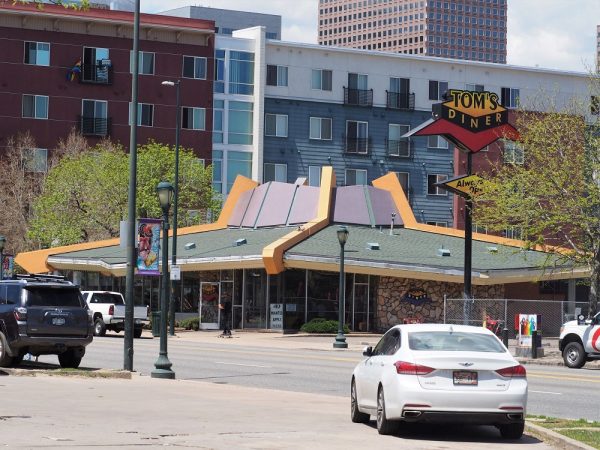There are now two sides to the future of Tom’s Diner.
On one side, there’s owner Tom Messina — yes, the name has been literal — and Greenwood Village-based Alberta Development. Messina wants to sell his diner at 601 E. Colfax Ave. to Alberta, which wants to demolish it and build an eight-story residential building on the half-acre lot.
On the other side, there are five Denver residents, who on Friday requested the city designate the retro-looking building a landmark, against Messina’s wishes. If approved, the designation would make demolition very difficult.
“We appreciate that we’re not making this easy on Tom,” Jessica Caouette, one of those five residents, told BusinessDen Friday. “But we want to slow down the process and get this building the recognition it deserves.”
Friday was the last day community members could request the landmark designation, following Messina’s May request that the city dub the building, which was listed for $4.8 million, as “non-historic.”
In addition to Caouette — who owns Tandem Bar in Uptown — the landmark designation was requested by Sam Dorrance, Kristin Morales, Kaye Taavialma and Jonel Beach.
Caouette said she was surprised to hear last month that the diner could be demolished, because “we thought that this was a protected building.” Caouette grew up in Denver, and the diner has been “a place that we knew we could be ourselves.”
“We also really love the architectural style, with the ’60s diner look … it’s a beautiful building,” she said.
Caouette said she reached out to local preservation nonprofit Historic Denver to learn more about the landmark designation process, and that organization staff pledged to support her and others as they moved forward with the application.
The diner now known as Tom’s was built in 1967, according to the listing for sale. It was initially part of Denver’s White Spot diner chain, and is an example of Googie architecture. According to a February Denver Post story, Messina began leasing the space in 1999. Records show he bought the property in March 2004 for $800,000.
Caouette said she and her co-applicants haven’t spoken directly with Messina or Alberta Development. However, Historic Denver has, and Executive Director Annie Levinsky said the organization discussed “ideas on how the building could be incorporated into the development, and whether there are alternatives to demolition.”
“We’d hoped to continue those conversations outside the city process, which sets a specific and compressed timeline,” she said in an email. “However, with so little time we weren’t able to do that, and without an alternative several community members have decided to go forward and file the designation application so that the conversation can continue.”
Alberta Development also did not respond to a request for comment, and Messina did not respond to a message relayed through the broker listing his property.
The city charges $875 for a landmark application (it’s less if the property owner is requesting the designation). Caouette and her partners raised more than that on GoFundMe when they publicized their effort.
The landmark application now will be received by the city’s Landmark Preservation Commission. If the commission agrees that the building is worthy of the status, it will pass the request on to City Council, which would have the final say.
Caouette said that she’d love to see Alberta or another party buy the property from Messina, but preserve the diner and only build on the parking lot to the north of it. Ideally, Messina would get the amount that Alberta is currently offering.
“Tom deserves a fat payout,” she said, adding, “We do understand that what we’re asking is idealistic.”
Caouette said she isn’t really looking forward to a battle in front of council. She hopes that Messina and the developer agree with her vision by the time it gets to that stage.
That said, she’s serious about the application.
“The landmark designation saves the building,” Caouette said. “And that’s what we want to do.”
There are now two sides to the future of Tom’s Diner.
On one side, there’s owner Tom Messina — yes, the name has been literal — and Greenwood Village-based Alberta Development. Messina wants to sell his diner at 601 E. Colfax Ave. to Alberta, which wants to demolish it and build an eight-story residential building on the half-acre lot.
On the other side, there are five Denver residents, who on Friday requested the city designate the retro-looking building a landmark, against Messina’s wishes. If approved, the designation would make demolition very difficult.
“We appreciate that we’re not making this easy on Tom,” Jessica Caouette, one of those five residents, told BusinessDen Friday. “But we want to slow down the process and get this building the recognition it deserves.”
Friday was the last day community members could request the landmark designation, following Messina’s May request that the city dub the building, which was listed for $4.8 million, as “non-historic.”
In addition to Caouette — who owns Tandem Bar in Uptown — the landmark designation was requested by Sam Dorrance, Kristin Morales, Kaye Taavialma and Jonel Beach.
Caouette said she was surprised to hear last month that the diner could be demolished, because “we thought that this was a protected building.” Caouette grew up in Denver, and the diner has been “a place that we knew we could be ourselves.”
“We also really love the architectural style, with the ’60s diner look … it’s a beautiful building,” she said.
Caouette said she reached out to local preservation nonprofit Historic Denver to learn more about the landmark designation process, and that organization staff pledged to support her and others as they moved forward with the application.
The diner now known as Tom’s was built in 1967, according to the listing for sale. It was initially part of Denver’s White Spot diner chain, and is an example of Googie architecture. According to a February Denver Post story, Messina began leasing the space in 1999. Records show he bought the property in March 2004 for $800,000.
Caouette said she and her co-applicants haven’t spoken directly with Messina or Alberta Development. However, Historic Denver has, and Executive Director Annie Levinsky said the organization discussed “ideas on how the building could be incorporated into the development, and whether there are alternatives to demolition.”
“We’d hoped to continue those conversations outside the city process, which sets a specific and compressed timeline,” she said in an email. “However, with so little time we weren’t able to do that, and without an alternative several community members have decided to go forward and file the designation application so that the conversation can continue.”
Alberta Development also did not respond to a request for comment, and Messina did not respond to a message relayed through the broker listing his property.
The city charges $875 for a landmark application (it’s less if the property owner is requesting the designation). Caouette and her partners raised more than that on GoFundMe when they publicized their effort.
The landmark application now will be received by the city’s Landmark Preservation Commission. If the commission agrees that the building is worthy of the status, it will pass the request on to City Council, which would have the final say.
Caouette said that she’d love to see Alberta or another party buy the property from Messina, but preserve the diner and only build on the parking lot to the north of it. Ideally, Messina would get the amount that Alberta is currently offering.
“Tom deserves a fat payout,” she said, adding, “We do understand that what we’re asking is idealistic.”
Caouette said she isn’t really looking forward to a battle in front of council. She hopes that Messina and the developer agree with her vision by the time it gets to that stage.
That said, she’s serious about the application.
“The landmark designation saves the building,” Caouette said. “And that’s what we want to do.”






To any owners who want to avoid this, you can file with the landmark group to have a property designated NON-Historic. This will stop anyone from taking control of your investment without paying anything towards it.
Hi, Gem. Reporter here. To be clear, the property owner in this case did file for the property to be designated non-historic. In response to that request, these residents are requesting it be instead designated a landmark .
Landmark designation is tricky as all agree can in fact challenge one’s property rights HOWEVER one should consider in their pro-forma buildings/districts with historic designations and/or adaptive reuse incorportaing historic elements generate greater ROI both short and long-term.
Colfax Ave is unique in its urban fabric with many examples of architecture representing the post WWII mobility afforded by the personal automobile. In the 60’s and 70’s we razed many historic late 19th and early 20th century structure in the name of progress and now regret as we witness the demand for spaces similar to Larimer Square.
While post-war architecture value is still debated look at the values in Krisana Park/ Arapahoe Acres; continued demand for Mid Century Modern (MCM) homes. With the north parking lot the building housing Tom’s Diner could be easily incorporated as a gateway entry AND preserve views for those units facing south. The Planning office can assist with a PUD shifting for allowable density within the zone lot to achieve.
A similar example of such an adaptive reuse can be found in The Neon Museum in Las Vegas; their visitor center is located inside the historic La Concha Motel lobby. The curvilinear La Concha Motel lobby is a striking example of Mid-Century modern design characterized by Atomic- and Space Age shapes and motifs.
Closer to Colfax/Denver, the Central Library in which Michael Graves preserved and incorporated the timeless designs of Burnham Hoyt’s vision of International Style into his own whimsical post-modern addition. Of note I am a fan of Bastiens on E. Colfax for the food and design.
In the early 80’s, Colfax was one of my stomping grounds. Would take my sign painting truck to get supplies up in denver…after i first shot pool all night at the pool halls of course! i’m quite sure i frequented this white spot restaurant. Brings back memories. But progress must march on. I hope they come up with some “meet halfway” deal. It’s hard to let go of things we have, among other things, took for granted.
Though my time in colorado was only a few years, i’m persuading to my associates to do our biz startup in the denver/front range region.
I love your reporting & stories. Keep up the great work! Your media here is a large part of the future of this booming town!
This is one of the reasons behind the housing crisis in Denver. Selfish people like Jessica Caouette want a place for themselves to live in, but don’t want to build houses for other people to live in. The Bay Area is a perfect example of what happens when we let poor housing policy prevail, there are massive homeless encampments in every major city. Then, the same people that stopped housing development turn around and complain about the homeless problem and crime.